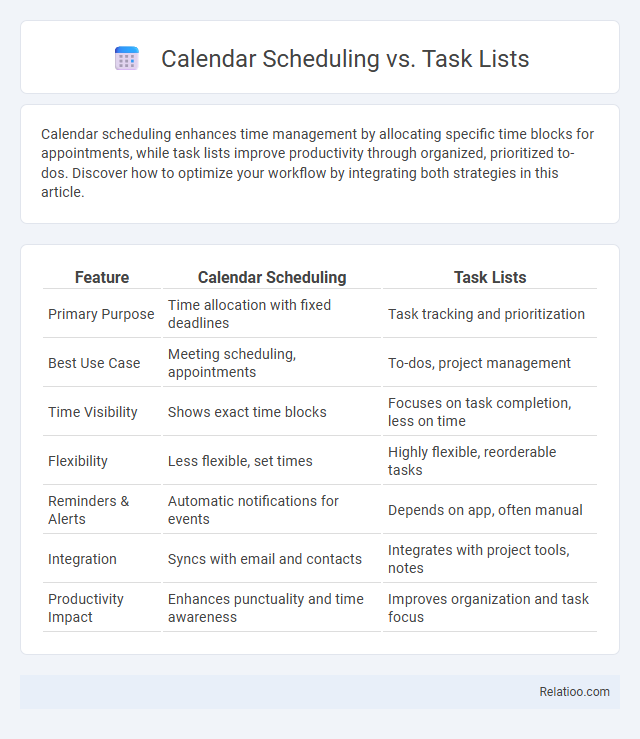Calendar scheduling enhances time management by allocating specific time blocks for appointments, while task lists improve productivity through organized, prioritized to-dos. Discover how to optimize your workflow by integrating both strategies in this article.
Table of Comparison
| Feature | Calendar Scheduling | Task Lists |
|---|---|---|
| Primary Purpose | Time allocation with fixed deadlines | Task tracking and prioritization |
| Best Use Case | Meeting scheduling, appointments | To-dos, project management |
| Time Visibility | Shows exact time blocks | Focuses on task completion, less on time |
| Flexibility | Less flexible, set times | Highly flexible, reorderable tasks |
| Reminders & Alerts | Automatic notifications for events | Depends on app, often manual |
| Integration | Syncs with email and contacts | Integrates with project tools, notes |
| Productivity Impact | Enhances punctuality and time awareness | Improves organization and task focus |
Understanding Calendar Scheduling
Calendar scheduling enhances time management by visually organizing appointments and deadlines within specific time slots, ensuring effective allocation of daily hours. Unlike task lists, which prioritize to-do items without fixed times, calendar scheduling provides a structured framework to prevent overlap and conflicts by clearly displaying commitments. This method optimizes productivity and reduces stress by allowing users to anticipate workload and allocate appropriate focus periods.
What Are Task Lists?
Task lists are organized collections of individual activities or goals that help you prioritize and track your progress efficiently. Unlike calendar scheduling, which allocates specific time slots for appointments or events, task lists provide flexibility by focusing on what needs to be done without strict timing. Understanding the distinction between task lists and calendar scheduling can prevent overlap, improving your productivity by ensuring tasks are completed without conflicting with scheduled commitments.
Key Differences Between Calendar Scheduling and Task Lists
Calendar scheduling organizes your time by allocating specific time slots for appointments and events, ensuring precise time management and deadlines. Task lists prioritize and track tasks without assigned time, offering flexibility but less structure in managing when tasks are completed. Overlap occurs when tasks lack scheduled time, leading to potential conflicts or missed deadlines in your daily planning.
Benefits of Using Calendar Scheduling
Calendar scheduling optimizes your time management by visually organizing appointments and deadlines, reducing the risk of overbooking and missed commitments. Unlike task lists that track individual actions, calendar scheduling provides a comprehensive overview of your day, enabling efficient prioritization and real-time adjustments. Using calendar tools enhances productivity by syncing events across devices and sending timely reminders, ensuring you stay on track with your goals.
Advantages of Task Lists
Task lists offer clear advantages by providing a straightforward way to prioritize and organize your daily activities, ensuring that important tasks are not overlooked. Unlike calendar scheduling, task lists allow flexible time management without rigid time blocks, giving you control over your productivity flow. Your ability to easily update and rearrange tasks enhances focus and reduces the cognitive load associated with managing overlapping commitments.
When to Use Calendar Scheduling
Calendar scheduling is ideal for managing fixed appointments and time-sensitive commitments, allowing you to allocate specific time slots for meetings, deadlines, and events. It ensures efficient time blocking, reducing conflicts and helping you visualize your day clearly. Use calendar scheduling when you need precise control over your daily timeline and want to avoid overlap with other tasks or responsibilities.
Ideal Scenarios for Task Lists
Task lists offer an ideal solution for managing detailed activities requiring prioritization and progress tracking, especially in project management and personal productivity contexts. Your tasks become clearly organized by deadlines and statuses, making it easier to focus on completion without the rigidity of fixed time slots found in calendar scheduling. Overlap issues are minimized as task lists allow flexible adjustment based on changing priorities, unlike calendar events that may conflict with each other.
Integrating Calendar Scheduling with Task Lists
Integrating calendar scheduling with task lists enhances productivity by ensuring Your appointments and tasks are synchronized for optimal time management. This approach minimizes overlap by visually linking deadlines and scheduled events, allowing you to allocate appropriate time slots effectively. Seamless integration helps prevent conflicts, boosts accountability, and streamlines workflow management.
Common Pitfalls and How to Avoid Them
Calendar scheduling, task lists, and overlap present unique challenges that impact productivity and time management. Common pitfalls include overloading calendars without buffer time, creating overly long task lists leading to overwhelm, and failing to account for task overlap causing missed deadlines or burnout. To avoid these issues, prioritize realistic time allocation, break tasks into manageable chunks, and identify potential overlaps early to optimize scheduling efficiency.
Choosing the Right Productivity Tool for You
Calendar scheduling enables precise time allocation for appointments and deadlines, optimizing daily workflows by visualizing commitments. Task lists prioritize action items and track progress, boosting focus on individual responsibilities without time constraints. Overlap combines time blocking with task management, ensuring balanced workloads and reducing calendar conflicts for enhanced productivity.

Infographic: Calendar Scheduling vs Task Lists
 relatioo.com
relatioo.com